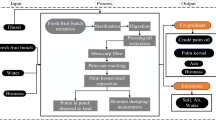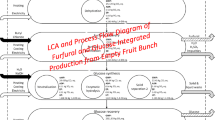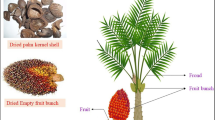Abstract
The purpose of this study is to provide a comprehensive assessment of oil palm biomass waste utilization, with the goal of providing palm oil mill owners the best options for biomass applications in order to limit carbon emissions and optimize economic potential. As the third largest producer of palm oil in the world, Thailand is very entrenched in the industry and thus is an ideal country to implement waste utilization strategies. The biomass byproducts result from the processing of fresh fruit bunches (FFB) from the oil palm plant in order to extract the main commodity, crude palm oil (CPO). This paper assesses six major biomass byproducts that result from the processing of the oil palm plants: empty fruit bunches (EFB), palm kernel shells (PKS), mesocarp fiber, oil palm fronds, oil palm trunks, and palm oil mill effluent (POME). The associated net greenhouse gas emissions were calculated for each biomass’ potential utilization pathway. The results of the study found that 4 of the 6 biomass waste products have alternative utilization options that resulted in net negative carbon emissions. Regarding the utilization options that are recommended, EFB shows net emissions of −0.14 t CO2 equivalent, −5.33 for shells, −17.68 for fiber, and −0.594 for trunks. In addition, the assessment of the added value for each product guides decision making to ensure economic viability. This analysis is unique in that it encompasses various utilization pathways for each of the major oil palm waste products in one comprehensive study. By comparing the results of these pathways, an optimal use for every waste product is recommended to decrease the overall climate change impact of the mill.















Similar content being viewed by others
Change history
04 February 2017
An erratum to this article has been published.
References
Dallinger, J. (2011) Oil Expansion in Southeast Asia. Oil Palm Development in Thailand: Economic, Social and Environmental Considerations. http://www.forestpeoples.org/sites/fpp/files/publication/2011/11/oil-palm-expansion-southeastasia-2011-low-res.pdf. Accessed 20 June 2016.
Global Palm Oil Production (2016) Global palm oil production 2016/2017. http://www.globalpalmoilproduction.com. Accessed 20 June 2016.
Chavananand K (2013). Palm Oil Residue Waste Potential and Waste Utilization in Thailand. In Clean Power Asia Conference and Expo 2013. http://www.engerati.com/sites/default/files/Day2-1620-Krisada%20Chavananand-CPA13.pdf. Accessed 20 June 2016.
Embrandiri A (2015) Sustainable Utilization of Oil Palm Wastes: Opportunities and Challenges. Nova Science.
Finkbeiner M (2009) Carbon footprinting- opportunities and challenges. Int J Life Cycle Assess 14:91–94 Retrieved from http://www.lifecycleinitiative.org/wpcontent/uploads/2012/12/Carbon-Footprinting-opportunities-ans-threats.pdf
Chanlongphitak S (2015) Life Cycle Assessment of Palm Empty Fruit Bunch Utilization for Power Plants in Thailand. Paper presented at International Conference on Biological, Environment and Food Engineering: Singapore. http://iicbe.org/upload/4352C0515048.pdf. Accessed 20 June 2016.
Suksomboon SiriBoon, S., Mr. (2016) Suksomboon Biorefinery [Personal interview]
Delivand MK, Gnansounou E (2013) Life cycle environmental impacts of a prospective palm-based biorefinery in Pará State-Brazil. Bioresour Technol 150:438–446. doi:10.1016/j.biortech.2013.07.100
Uemura Y, Omar WN, Tsutsui T, Yusup SB (2011) Torrefaction of oil palm wastes. Fuel 90(8):2585–2591. doi:10.1016/j.fuel.2011.03.021
Silalertruksa T, Gheewala SH (2012) Environmental sustainability assessment of palm biodiesel production in Thailand. Energy 43(1):306–314
Sun Y, & Cheng J (2002) Hydrolysis of lignocellulosic materials for ethanol production: A review. Bioresour Technol, (83), 1-11.
Ahmad SM, Subramaniam V, Mohammad H, Mokhtar A, Ismail BS (2014) Life cycle assessment for oil palm based plywood: A gate-to-gate case study. Am J Environ Sci 10(1):86–93. doi:10.3844/ajessp.2014.86.93
Giz. "Thailand: Renewable Energy Policy Update." Federal Ministry of Economic Affairs and Energy (Germany). (2015). Web. Apr. 2016.
Kaewmai R, H-Kittikun A, Musikavong C (2012) Greenhouse gas emissions of palm oil mills in Thailand. Int J Greenhouse Gas Control 11:141–151
Hansen SB, Olsen SI, Ujang Z (2012) Greenhouse gas reductions through enhanced use of residues in the life cycle of Malaysian palm oil derived biodiesel. Bioresour Technol 104:358–366. doi:10.1016/j.biortech.2011.10.069
Kumar D, Murthy GS (2011) Impact of pretreatment and downstream processing technologies on economics and energy in cellulosic ethanol production. Biotechnol Biofuels 4(27). doi:10.1186/1754-6834-4-27
CDM (2015) AMS-III.H.: Methane recovery in wastewater treatment --- version 15.0.
Kumar D, Murthy GS (2012) Life cycle assessment of energy and GHG emissions during ethanol production from grass straws using various pretreatment processes. Bioresour Technol 17(4):388–401
Budsberg E (2013) Life cycle assessment of biofuels produced from short rotation woody crops (Order No. 1551003). Available from ProQuest Dissertations & Theses Global. (1497035162). Retrieved from http://search.proquest.com/docview/1497035162?accountid=1424. Accessed 20 June 2016.
Chiew YL (2013) Current state and environmental impact assessment for utilizing oil palm empty fruit bunches for fuel, fiber and fertilizer – A case study of Malaysia. Biomass Bioenergy 51:109–124
Gomez D (2006) Stationary Combustion. Default Emission Factors for Stationary Combustion in the Energy Industry, 2, 16-17. Retrieved from http://www.ipccnggip.iges.or.jp/public/2006gl/pdf/2_Volume2/V2_2_Ch2_Stationary_Combustion.pdf. Accessed 20 June 2016.
Arena N (2016) Life Cycle Assessment of activated carbon production from coconut shells. J Clean Prod 125:68–77
Homagain K (2015) Life cycle environmental impact assessment of biochar-based bioenergy production and utilization in Northwestern Ontario. Canada J For Res 26(4):799809
Filiberto DM (2013) Practicality of biochar additions to enhance soil and crop productivity. Agriculture 3:715–725. doi:10.3390/agriculture3040715
Adams P (2015) Comparative cradle-to-gate life cycle assessment of wood pellet production with torrefaction. Elsevier 138:367–380
Batelle (2013) Logistics, Costs, and GHG Impacts of Utility Scale Co-firing with 20% Biomass. Prepared for U.S. Department of Energy Bioenergy
Chen S (2009) Life Cycle Assessment of Wood Pellet. Chalmers University of Technology .http://publications.lib.chalmers.se/records/fulltext/141464.pdf. Accessed 20 June 2016.
Lee K (2013) Environmental sustainability assessment of biofuel production from oil palm biomass. Green Energy Technol 3:149–187. doi:10.1007/978-981-4451-70-3_5
NETL Life Cycle Inventory Data – Unit Process: Short Rotation Woody Crop Biomass Torrefaction (2012) U.S. Department of Energy, National Energy Technology Laboratory. Retrieved from http://www.netl.doe.gov/energy analyses/temp/DF_Stage2_O_SRWC_Biomass_Torrefaction_2012-01.pdf. Accessed 20 June 2016.
Shen X, Kommalapati RR, Huque Z (2015) The Comparative Life Cycle Assessment of Power Generation from Lignocellulosic Biomass. Sustainability 7(10):1297412987. doi:10.3390/su71012974
Xu X, Jayaraman K, Morin C, Pecqueux N (2007) Life cycle assessment of woodfiber-reinforced polypropylene composites. J Mater Process Technol 198(1-3):168–177
Shinoj S, Visvanathan R, Panigrahi S (2010) Towards industrial utilization of oil palm fibre: Physical and dielectric characterization of linear low density polyethylene composites and comparison with other fibre sources. Bioprocess Biosyst Eng 106(4):378–388. doi:10.1016/j.biosystemseng.2010.04.008
Puettmann M, Bergman R, & Oneil E (2016). Cradle-to-gate life-cycle assessment of cellulosic fiberboard produced in North America. CORRIM. Retrieved from https://www.researchgate.net/publication/276269193_Cradle-to-gate_life-cycle_inventory_of_cellulosic_fiberboard_produced_in_North_America. Accessed 20 June 2016.
Reed D, Bergman R, Kim J, Taylor A, Harper D, Jones D et al (2012) Cradle-to-gate life-cycle inventory and impact assessment of wood fuel pellet manufacturing from hardwood flooring residues in the southeastern United States. Forest Prod J 62(4):280–288
Wiens M, Kariyapperuma K, Dias GM, Friesen G, & Dadfar H (2014) Life cycle assessment of alfalfa-grass hay production in manitoba. . Retrieved from https://umanitoba.ca/faculties/afs/agronomists_conf/media/Wiens_AlfalfaGrass_Hay_poster_De c_1_final_2014.pdf. Accessed 20 June 2016.
Yusoff S, Hansen SB (2007) Feasibility Study of Performing an Life Cycle Assessment on Crude Palm Oil Production in Malaysia. Int J LCA 12(1):50–58
Wood S, & Cowie A (2004) A Review of Greenhouse Gas Emission Factors for Fertiliser Production. Retrieved from https://www.researchgate.net/publication/279200914_Life_cycle_assessment_LCA_of_different _fertilizer_product_types. Accessed June 20, 2016.
US EPA (2007) Emissions from Soils- Greenhouse Gases. Retrieved from https://www3.epa.gov/ttnchie1/ap42/ch14/final/c14s01.pdf Accessed June 20, 2016.
Cordero T, Marquez F, Rodriguez-Mirasol J, Rodriquez J (2001) Predicting heating values of lignocellulosics and carbonaceous materials from proximate analysis. Fuel 80:15671571 Retrieved from http://www.biblioteca.uma.es/bbldoc/tesisuma/16665892.pdf. Accessed 20 June 2016.
Ahmad SM, Subramaniam V, Mohammad H, Mokhtar A, Ismail BS (2014) Life cycle assessment for oil palm based plywood: A gate-to-gate case study. Am J Environ Sci 10(1):86–93. doi:10.3844/ajessp.2014.86.93
Kaewmai R, H-Kittikun A, Musikavong C (2012) Greenhouse gas emissions of palm oil mills in Thailand. Int J Greenhouse Gas Control 11:145–151
Carbon Bridge Pte Ltd. (2008) Univanich Lamthap POME Biogas Project Thailand. website: http://www.llv.li/files/au/pdf-llv-au-pdd_univanich.pdf. Accessed 7 May 2016.
Poh PE, Chong MF (2009) Development of anaerobic digestion methods for palm oil mill effluent (POME) treatment. Bioresour Technol 100(1):1–9
CDM – Executive Board (2011) Wastewater treatment with biogas system in palm oil mill at sikao, trang, Thailand. Retrieved from Project Design Document Form (CDM-SSC-PDD) - Version 03
Lycopodium Process Industries Pty Ltd. (2015) Review and Cost Benefit Analysis of Torrefaction Technology for the Processing of Abattoir Waste.
What is the CDM (2016) Retrieved from UNFCCC Official Page: https://cdm.unfccc.int/about/index.html. Accessed 20 June 2016.
Mani S (2006) Economics of Producing Fuel Pellets from Biomass. Appl Eng Agric 22(3):1–6. doi:10.13031/2013.20447
Kobkanjanakorn K Green Energy Network. Palm Oil Residues Power Plant, Case Study and Potential of Thailand. http://pennwell.sds06.websds.net//2015/bangkok/apw/slideshows/T5S3O4-slides.pdf. Accessed 20 June 2016.
Alam Z (2007) Activated carbons derived from oil palm empty-fruit bunches: Application to environmental problems. J Environ Sci 19:103–108
Shackley S (2011) The feasibility and costs of biochar deployment in the UK. Carbon Management 2(3):335–356
Ranta T (2015) Demonstration of handling and logistics of torrefied pellets. 23rd European Biomass Conference and Exhibition, 1048-1053. doi:10.5071/23rdEUBCE20153DO.9.5
Uslu A, Faaij AP, Bergman P (2008) Pre-treatment technologies, and their effect on international bioenergy supply chain logistics. Techno-economic evaluation of torrefaction, fast pyrolysis and pelletisation. Energy 33(8):1206–1223. doi:10.1016/j.energy.2008.03.007
Bourgault G (2014) Market for Polypropylene, granulate. Retrieved from https://v31.ecoquery.ecoinvent.org/Details/UPR/82015f49-c812-49e1-adce9f3d5072ffe6/8b738ea0-f89e-4627-8679-433616064e82. Accessed 20 June 2016.
Mechanics of Materials (1999). Retrieved from http://ocw.mit.edu/courses/materialsscience-and-engineering/3-11-mechanics-of-materials-fall-1999/modules/props.pdf. Accessed 20 June 2016
Zampaloni, M., Pourboghrat, F., Yankovich, S., Rodgers, B., Moore, J., Drzal, L., . . . Misra, M. (2007) Kenaf natural fiber reinforced polypropylene composites: A discussion on manufacturing problems and solutions. Composites Part A: Applied Science and Manufacturing, 38(6), 1569-1580. doi:10.1016/j.compositesa.2007.01.001
North American Wood Fiber Review (2012) Wood Resources International LLC. Retrieved from http://woodprices.com/wp-content/uploads/2015/05/NAWFR-SAMPLE.pdf Accessed 20 June 2016
Hakeem K, Jawaid M, Rashid U (2014) Processing and Properties. Biomass Bioenergy. doi:10.1007/978-3-319-07641-6
Merlo C (2015) Alfalfa hay prices expected to soften in 2015, but long-term outlook is strong. AgWeb. Retrieved from http://www.agweb.com/article/alfalfa-hay-prices-expected-tosoften-in-2015-but-long-term-outlook-is-strong-naa-catherine-merlo/. Accessed 20 June 2016.
Pirraglia A, Gonzalez R, & Saloni D (2010) Techno-economical analysis of wood pellets production for us manufacturers. BioResources, 5(4), 2374-2390. Retrieved from https://www.ncsu.edu/bioresources/BioRes_05/BioRes_05_4_2374_Pirraglia_GS_Techno_Econ _Anal_Wood_Pellets_US_Prodn_1108.pdf. Accessed 20 June 2016.
Timber prices (2016) Malaysian Timber Industry Board. Retrieved from http://www.mtib.gov.my/index.php?option=com_content&view=article&id=87&Itemid=88&lan g=en. Accessed 20 June 2016.
Ismail A, Arif Simeh M, & Noor M (2003) The production cost of oil palm fresh fruit bunches: The case of independent smallholders in johor. Oil Palm Industry Economic Journal, 3(1). Retrieved from https://www.researchgate.net/publication/242681084_The_Production_Cost_of_Oil_Palm_Fresh _Fruit_Bunches_the_Case_of_Independent_Smallholders_in_Johor. Accessed 20 June 2016.
IRENA (2012) Renewable Energy Technologies: Cost Analysis Series. International Renewable Energy Agency, 1(1), 5th ser. https://www.irena.org/DocumentDownloads/Publications/IRENA-ETSAP%20Tech%20Brief%20E21%20Biomass%20Co-firing.pdf. Accessed 20 June 2016.\
Hassan A, Salema AA, Ani FN, Bakar AA (2010) A review on oil palm empty fruit bunch fiber-reinforced polymer composite materials. Polym Compos 31(12):2079–2101. doi:10.1002/pc.21006
Alves HJ, Junior CB, Niklevicz RR, Frigo EP, Frigo MS, Coimbra-Araujo CH (2013) Overview of hydrogen production technologies from biogas and the applications in fuel cells. Int J Hydrog Energy 38(13):5215–5225
Koonaphapdeelert S (2013) Challenges in Developing CBG Projects in Thailand [Powerpoint slides]. Retrieved from http://news.ubmthailand.com/Newsletter/2013/EPA/Files/SessionIV/01Presentation_Dr.%20Sirichai%20Koonaphapdeelert.pdf. Accessed 20 June 2016.
Acknowledgements
The authors would like to acknowledge the Joint Graduate School of Energy and the Environment at King Mongkut’s University of Technology Thonburi for the opportunities provided to conduct this research. In addition, much gratitude is expressed for the mentorship and support received from Dr. Thapat Silalertruska, Mr. Naruetep Lecksiwilai, Dr. Richard Kamens, Dr. Savitri Garivait, Dr. Pham Bich Thao, Suksomboon Biorefinery, and the UNC Chapel Hill Study Abroad program.
Author information
Authors and Affiliations
Corresponding author
Additional information
The original version of this article was revised: The last word in the title which was supposed to be “perspective” is missing. The correct title is shown above.
An erratum to this article is available at https://doi.org/10.1007/s13399-017-0245-y.
Electronic supplementary material
ESM 1
(DOCX 31 kb)
Rights and permissions
About this article
Cite this article
Beaudry, G., Macklin, C., Roknich, E. et al. Greenhouse gas assessment of palm oil mill biorefinery in Thailand from a life cycle perspective. Biomass Conv. Bioref. 8, 43–58 (2018). https://doi.org/10.1007/s13399-016-0233-7
Received:
Revised:
Accepted:
Published:
Issue Date:
DOI: https://doi.org/10.1007/s13399-016-0233-7




